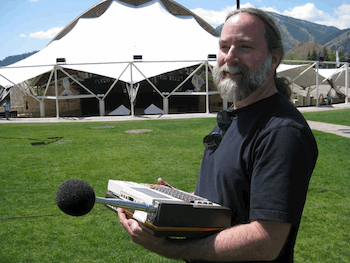- Steve Barbar Uses A Lifetime of Learned Skills to Translate Musicianship Through Electronics
NAME: Steve Barbar
TITLE: President
COMPANY: LARES Associates/E-Coustic Systems
SILENT PARTNER: Over the years, countless numbers of patrons enjoyed performances where his systems are installed without knowing the technology at work.SCN: At what point in your life did you realize you were destined for a career in audio?
Steve Barbar: I have always been curious about electronics and audio. I grew up with crystal radio kits, rebuilt tube radios, and had my first reel-to-reel when I was 10. I played electric guitar in my teens, and was fortunate to meet some very talented jazz musicians who were my age. I realized that I could commit 12 hours a day for the next 20 years and maybe come close to their talent, or I could use skills that I had garnered to faithfully translate their musicianship through electronics—either to a recording medium, or to an audience though a sound system.SCN: Was there one “missing element” in audio systems and acoustic design that provided the impetus for your development of LARES at Lexicon in the 1980s?
SB: The concept using electro-acoustic tools to alter room acoustics is almost as old as electricity itself. Early systems implemented in the 1960s and 1970s were very complex, and provided negligible adjustability. Also, components built at that time had numerous reliability issues. Dr. David Griesinger (Lexicon’s chief scientist, who developed the first viable digital reverb) and I were asked to determine if there was a practical solution. LARES was the culmination of that research, and the Elgin Theatre in Toronto, ON, Canada was the first installation. The “missing element” constitutes acoustical conditions that are optimum for a performance—both for the artists as well as the audience. Reconstructing a building every day in order to provide optimal acoustics for different ensembles is a bit impractical. Our systems achieve this for a wide variety of programming without radically changing the architecture to accommodate different requirements.

Steve Barbar
SCN: What is the most satisfying aspect of treating a formerly nightmarish space and creating a beautiful new acoustic signature?
SB: It makes listening to music enjoyable, and when it is optimum the experience transcends listening. This is when the music can send a chill, or raise the hair on your neck. When the music is this engaging, you want to come back for the same experience.
SCN: LARES helped bring indoor concert sound outdoors at Millennium Park in Chicago. How does the audience benefit from such a treatment?
SB: We have a number of successful outdoor installations. One of the greatest benefits is that outdoor installations provide a more common musical experience throughout the venue. In a hall, the perception of direct sound may change at different locations—in contrast the reverberation remains similar. Outdoor sound reinforcement systems typically amplify only the direct sound. Adding reverberation helps, but this is a vastly different than a good seat in a hall, or any immersive sonic experience. The reflections and reverberation building from a multitude of directions are the “missing element” in outdoor sound. Additionally, the decay of the reflections and reverberation helps to mask intrusive noise, making the experience more immersive. As you walk from the perimeter of Millennium Park onto the lawn or seating area you can “feel” the change in the music.
SCN: Where do you see electro-acoustic enhancement headed in the future?
SB: Our systems are installed in a wide range of applications including music performance and rehearsal, worship, recording, drama, training, conferencing, etc. New venues specifically designed to utilize this technology are growing exponentially. Many existing installations wish to broaden their artists and programs. Our new hardware makes it practical to offer platforms targeted for specific markets; thereby lowering entry level cost which makes the technology a tool of choice for a wider range of applications.
The advent of digital audio has dramatically shifted expectations for sonic quality. Simply put, we expect that the artist performing will be intimate and clear with optimum spaciousness, envelopment and reverberant decay. We expect the person speaking will be intelligible and articulate with optimum support from reflected energy. We expect that in a place like a house of worship, that this will somehow magically take place even thought the requirements for music conflict directly with the requirements for the spoken word.
Before the invention of digital reverberation, it was difficult if not impossible to optimize the ambience in recorded music. One only needs listen to recordings made before World War II to hear the fundamental difference in recording technique when compared to modern recordings. Digital reverberation provided the means to adjust the acoustic conditions based solely on the nature of the music or sound source. Hence, we have a 30 year record of recorded music with acoustical characteristics determined in this manner. This record points out how similar human hearing is across the species, and our general preferences for acoustic conditions. If we fundamentally wanted something else, the record would have been different.










